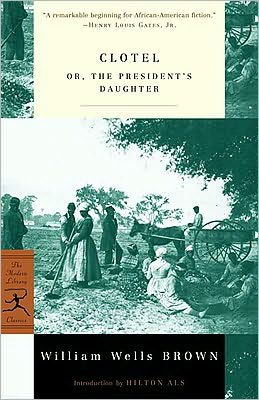The first novel published by an African American, Clotel takes up the story, in circulation at the time, that Thomas Jefferson fathered an illegitimate mulatto daughter who was sold into slavery. Powerfully reimagining this story, and weaving together a variety of contemporary source materials, Brown fills the novel with daring escapes and encounters, as well as searing depictions of the American slave trade. An innovative and challenging work of literary invention, Clotel is receiving much renewed attention today.
William Wells Brown, though born into slavery, escaped to become one of the most prominent reformers of the nineteenth century and one of the earliest historians of the black experience. This Modern Library Paperback Classics edition reproduces the first, 1853, edition of Clotel and includes, as did that edition, his autobiographical narrative, "The Life and Escape of William Wells Brown," plus newly written notes.
1100184166
William Wells Brown, though born into slavery, escaped to become one of the most prominent reformers of the nineteenth century and one of the earliest historians of the black experience. This Modern Library Paperback Classics edition reproduces the first, 1853, edition of Clotel and includes, as did that edition, his autobiographical narrative, "The Life and Escape of William Wells Brown," plus newly written notes.
Clotel: or, The President's Daughter
The first novel published by an African American, Clotel takes up the story, in circulation at the time, that Thomas Jefferson fathered an illegitimate mulatto daughter who was sold into slavery. Powerfully reimagining this story, and weaving together a variety of contemporary source materials, Brown fills the novel with daring escapes and encounters, as well as searing depictions of the American slave trade. An innovative and challenging work of literary invention, Clotel is receiving much renewed attention today.
William Wells Brown, though born into slavery, escaped to become one of the most prominent reformers of the nineteenth century and one of the earliest historians of the black experience. This Modern Library Paperback Classics edition reproduces the first, 1853, edition of Clotel and includes, as did that edition, his autobiographical narrative, "The Life and Escape of William Wells Brown," plus newly written notes.
William Wells Brown, though born into slavery, escaped to become one of the most prominent reformers of the nineteenth century and one of the earliest historians of the black experience. This Modern Library Paperback Classics edition reproduces the first, 1853, edition of Clotel and includes, as did that edition, his autobiographical narrative, "The Life and Escape of William Wells Brown," plus newly written notes.
7.99
In Stock
5
1

Clotel: or, The President's Daughter
256
Clotel: or, The President's Daughter
256Related collections and offers
7.99
In Stock

Product Details
| ISBN-13: | 9780307419279 |
|---|---|
| Publisher: | Random House Publishing Group |
| Publication date: | 07/16/2009 |
| Series: | Modern Library Classics |
| Sold by: | Random House |
| Format: | eBook |
| Pages: | 256 |
| File size: | 2 MB |
About the Author
From the B&N Reads Blog
